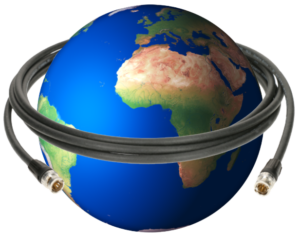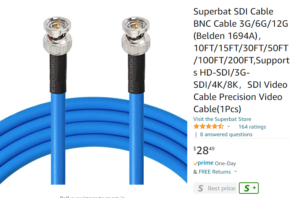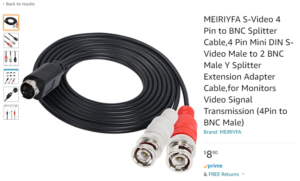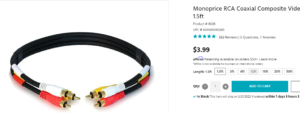 INTRODUCTION:
INTRODUCTION:
We at W. Cardone Productions often face challenges in duplicating legacy video and film into the digital domain. In fact, this distinguishes us within the industry because we look for avenues to leverage modern technology to optimize the process. What we produce is therefore actually BETTER than what was originally recorded.
The discussion which follows will examine a very specialized and highly technical video downloading problem that we had to solve here at W. Cardone Productions. However, this discussion will approach the subject from a qualitative perspective keeping it simple and consumer digestible. The target audience is the consumer although the technically proficient will find it fascinating. The only exception to the qualitative nature will be with respect to the time it takes a signal to travel down an electrical wire, ignoring velocity factor considerations. We will also ignore the discussion of harmonics in the interest of simplicity. The result will be an over-simplification of the process yet sufficient for illustrative purposes.
A CONSUMER SUMMARY
There is a principle in physics whereby electrical signals are reflected back to the source if termination and interface characteristic impedances are not matched. These electrical signals are reflected back at the same velocity at which they were sent—the speed of light. Therefore, a defined time is required for a signal to reach its termination or load and likewise, the same set of time is required if a portion of that signal is reflected back to the source.
So, here are some questions to consider.
- What sort of distortion should you expect to see at a 50 Ohm load when a signal generator (50 Ohm output impedance) sends a 5MHz square wave signal through a 100-meter cable (or any length) having a 50 Ohm characteristic impedance?
ANSWER: There will be no distortion resulting from this signal transmission with respect to impedances and cable length since all of the impedances are matched from source to load. There are no reflections to cause distortion. The length of the cable is irrelevant except for attenuation. This is an optimal case. There is no need to consider any temporal parameters. - Consider the same case except that the 100-meter cable has been replaced by a simple 100-meter hookup wire which, of course, has an unknown characteristic impedance and therefore is anything BUT 50 Ohms.
ANSWER: There will be intolerable distortion appearing at the load for two reasons.- The 5MHz signal takes 333nsec to travel the 100-meter length of hookup wire. But any one reflected wave only needs 100nsec to make its way back to the source. The reflection seriously distorts the signal coming out of the source causing it to be sending new distorted waves out which only become distorted all the more with the supplemental reflections.
- Because there is a cable characteristic impedance mismatch, there will be reflections on account of that cable impedance mismatch. It becomes a real mess.
- Consider the case as of 2 above except that now the cable length (hookup wire, again) has been shortened by a factor of one hundred (100x), from 100 meters to 1 meter. The cable’s characteristic impedance remains unknown.
ANSWER: Because impedances are mismatched, there will be reflections and therefore distortion as a function of those reflections. However, the distortion will be minimal (if even observable) and therefore easily tolerated in typical cases. Why is that? At 100 meters, the signal needed 333nsec to get back to the source. but now the path only requires 3nsec.
WHY IS CABLE LENGTH IMPORTANT TO LEGACY MEDIA DUPLICATION TO DIGITAL?
So, now we can address how this affects us and our duplication of legacy media into the digital domain.
Cable length was of virtually of no significance to us at W. Cardone Productions up until about 2012 when we radically altered the workflow defining how we go about the duplication of legacy video into the digital domain. We purchased a conversion device at the recommendation of Videoguys in New York. Videoguys is a good source for tips and tricks on doing all this stuff.
In 2012 we began using this device where each frame of a video download was processed in real-time during the download. Each frame was properly de-interlaced using the original temporal information present from the original recording. This happens in real-time as the video is fed into the download which means that there is a time limitation for this processing to occur. New frames keep coming down the pike and must be accepted for processing as they are delivered. In addition, each frame is up-resolved from the original 720i (interlaced) to 1080p (progressive) making additional demands for a time limitation per frame. The device must receive a clean and crisp video signal or else it will drop the signal which completely stops the download.
It stands to reason that there is no room for slop concerning the integrity of the video signal reaching the processor. The concern is not for a loss of quality but simply a loss of synchronization and a subsequent complete signal loss. The processor will quit altogether. The download must then be manually restarted from the beginning. As long as the signal reaches the processor and can be processed before the next frame arrives, quality is not an issue. Either the signal is received or it is not received.
In our technical example above, we had hookup wire connecting the signal source to the load. While hookup wire does have a characteristic impedance, the value of that characteristic impedance is impossible to be known. Further, it is not consistent for a given length of wire since it is a function of the conductor’s distance to the ground plane which is both unknown and not consistent for a given length of wire. Hookup wire is the equivalent of using many types of audio RCA connection cables. While these types of RCA connectors themselves on each end have a defined characteristic impedance, the cable connecting the two ends DOES NOT.
A WORD OF REFERENCE: In the discussion that follows, reference to “RCA connectors and cables” will be with reference to those lower-end types that do not have a defined characteristic impedance. These are therefore more properly identified as “hookup wire.” The higher quality cables that have a defined, and therefore consistent, characteristic impedance will have a fine-print text printed on the cable at equidistant intervals identifying the cable type. An Example is RG-59/U which has a 75 Ohm characteristic impedance.
KEY CONCEPT TO TAKE HOME:
Here’s the key concept to take home from this blog post. With mismatched impedances, the cable conducting the video signal can only be so long before there is significant signal distortion. For this discussion, the audio cables that are married to that video signal don’t have any relevant length limitations within reason because the audio frequencies are so low and wavelengths therefore so long. It is the cable carrying the video signal that we address in this discussion.
QUANTIFICATION: HOW LONG IS TOO LONG?
To address the question of how long is too long, we first need to establish the parameters we are working with. The maximum cable length (assuming unknown characteristic impedances) is a function of the shortest wavelength carried. The maximum length needs to be less than a tenth of that wavelength. A tenth is where the signal becomes grossly distorted virtually no longer recognizable from the original. But a goal should be a hundredth of that wavelength. At a hundredth, any distortion will be borderline and possibly non-observable. But in any case, shorter ALWAYS helps.
THE WEAKEST LINK:
In an NTSC video signal, the shortest component (the weakest link) is the color burst signal which is 3.6MHz. Its wavelength is 83 meters. We know that the absolute maximum cable length we even want to think about is a tenth of that which would be 8.3 meters or about 27 feet. At 27 feet, an RCA cable just might possibly conduct a video signal but don’t count on it. This just might work for the least demanding circumstances (highly unlikely). But at least we have quantified something that we can hang our hat on.

At a factor of one hundred, our chances of success start looking good. This translates 830cm or 2.7 feet. Let’s call it 1 meter.
At W. Cardone Productions, our workflow dating from 2012 is far more demanding than a 27 foot RCA video cable would facilitate. The best solution (if it must be RCA) would be to obtain the shortest cable available and plug it in to see if it will work. Therefore, let’s work backward using the shortest cable found to see what its derating factor is.
The shortest RCA cable we found was 1.5 feet. What factor does this represent with regard to cable derating? 18 inches or 46cm (0.46 meters). This cable beats our hundredth goal significantly coming in at a derating factor of 181.

EVALUATION:
We know that there is a good chance of success with an RCA cable that is 1 meter long. However, we have found an RCA cable that is 18 inches representing a derating factor of 181. This will give us our best chance for success.
HOW TO FURTHER IMPROVE CHANCES FOR SUCCESS:
 The use of an RCA cable has the limitation of working with an unknown characteristic impedance. Our results would be improved if we were to match impedances from source to load. In that case, cable length would become irrelevant for practical purposes.
The use of an RCA cable has the limitation of working with an unknown characteristic impedance. Our results would be improved if we were to match impedances from source to load. In that case, cable length would become irrelevant for practical purposes.
The download processing box used has a video SDI input specified to have 72 Ohms impedance with a BNC connection. We can use a pre-fabricated SDI cable such as that shown in the illustration. It has BNC connectors on both ends. The length is irrelevant to a practical extent since we have matched impedances.
However, it has to connect to legacy VHS machines. Therefore we have to transition from a 72 Ohm BNC to a 72 Ohm RCA adapter. Because the characteristic impedances match we are in business. But even if they did not match, the difference between 72 Ohm and 50 would be minimal.
LET’S DO A LITTLE BETTER:

A pro-grade VHS player will have an S-Video output port. For this you will want to use a cable such as is shown in the illustration. However, note that this one has 50 Ohm BNC connectors. It won’t blow you out of the water but it will work against you. Look for BNC connectors that are 72 Ohm.
WHERE THE RUBBER MEETS THE ROAD: WHAT WORKED
To this point, we have looked at a number of cable variations but there was one configuration that we actually used which provided the full performance of our video processing unit. So, what were the downfalls? There was only one downfall and that was video dropouts. The performance we expected was all of the advertised features of the video processing unit together with no dropouts.
 That solution was through the use of a shielded RCA Video/Audio cable that was short. In truth, it is likely that a longer RCA shielded cable would work as well but for our application, length was not an issue since the video processing box could be placed directly next to the VHS player.
That solution was through the use of a shielded RCA Video/Audio cable that was short. In truth, it is likely that a longer RCA shielded cable would work as well but for our application, length was not an issue since the video processing box could be placed directly next to the VHS player.
Looking at the fine print on the cable can be read “RG-59/U” which is 75 Ohm shielded cable. The fact that it is shielded means that it can have a defined, and therefore, consistent characteristic impedance. Video outputs and inputs are standardized at 75 Ohms impedance so this means an impedance match from end-to-end. Matched impedances are a guarantee an optimal power transfer.
But there is more to report on an optimal fit. With a less than optimal configuration, we observed that there was a characteristic delay in the video processing box’s ability to complete handshaking for a connected video signal. This meant a loss of video capture for the first two seconds of any download. Since the video connection is less than optimal, it was taking a significant time for the processing box to analyze the incoming signal and synchronize with it. An optimal solution facilitated an instantaneous linkup. While there continues to be a delay in this linkup, it is short enough to where it cannot be noticed even when watching for a delay.
